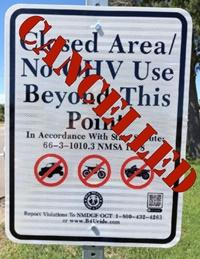The County Livestock Loss Authority passed a resolution on Dec. 6 in protest of the new USDA standards of evidence of a wolf kill, which was released over the summer.
For 18 years wildlife service investigators have used the same criteria to confirm a probable or confirmed wolf kill, according to Jim Paxon, Sierra County commissioner and chair on the CLLA. He said they use bite marks, flesh wounds, the kill scene, documentation of wolves in area and subcutaneous hemorrhaging to determine the cause of death.
“There are six other things that have always been considered (in a wolf kill), now the primary thing as of August 29th is subcutaneous hemorrhage, so if you don’t have it, they will not call it a confirmed kill they will call it a probable kill. This is fine except federal funds won’t pay for probable kills,” said Paxon.
Animal protection groups and proponents of the new standards say that evidence of subcutaneous hemorrhage prove that the animal was alive during the wolf encounter and help prevent Mexican gray wolves from being blamed unfairly for livestock depredation.
“The over-reported incidence of wolf involvement in cattle deaths in the southwest has had negative impacts on the wolf recovery program, including the killing and capture of wild wolves. We’re hoping the new standards help prevent that from happening again,” Greta Anderson, deputy director of Western Watershed Project said in a press release in August.
Paxon says the rules are discriminatory and inappropriate.
“Rural economies are so fragile right now, we must do everything we can to keep rural livestock alive,” said Paxon “They aren’t going to make beaucoup bucks out of this deal, they are going to get paid for damages and that’s all. It helps them stay on the ground for the generation to come.”
The resolution passed by CLLA on Wednesday, states that the new standards fail to account for the regional differences in ranching in New Mexico. Running cows on vast, unlevel expanses means that the vast majority of carcasses are rarely found within a period of time to permit the inspection of subcutaneous hemorrhaging, and that many wolf kills occur when calves are just hours old and no evidence is left of the depredation.
“Presently only federal funds can be used to compensate confirmed kills, with that said for those payments for probable kills have to come from the county or state funds. That is why we are requesting state funds this year from the legislature to help the CLLA pay for submitted requests on probable kills.” Ray Martinez said.
Ray Martinez is a Socorro County Commissioner who represents Socorro County on the CLLA board.
In this next legislative session Paxon said that the CLLA is asking 9 million dollars from legislators for the next three years. The funding would be used for depredations and indirect damage.
He explained the presence of wolves causes stress on livestock and can cause lower conception rates, weaning rates and livestock shipping weight. This causes indirect damage to ranchers that can be proved through their livestock records.
“We have all nine legislators supporting us on this,” Paxon said.
The County Livestock Lost Authority was formed in November 2022, with the purpose to compensate livestock lost to Mexican wolves. This includes cattle, horses, goats and sheep. The board is in a joint effort between Catron, Sierra and Socorro counties with each contributing financial support of $100,000 dollars into the funding.
They also work with the US Fish and Wildlife department and New Mexico Agriculture Department to get funding from federal and wildlife advocate groups.
“I’m glad I was selected to help on this committee so we, in Socorro County, will have a voice and help in getting compensated when it is approved as probable kills. The committee has worked very hard to be where we are today. All the committee members are very good and go the extra mile to help our ranchers get compensated,” Martinez said.
Martinez said that he’s available for any questions or help from the community about the process.
This year, Paxon said, they have paid out about $80,000 in depredations and they haven’t finished all the applications yet. Paxon estimated about 72 depredations were made this year with 57 paid out at this point. Applicants for the compensation are not required to be from the three counties. CLLA has made payments to ranchers in Grant and Hidalgo counties.
Paxon said that they are open to growing the board and include other counties who are willing to support CLLA financially.
The process for depredation can take about three to six months. When there is suspected kill, USDA wildlife service does the investigation and determines if it is a confirmed wolf kill, a probable wolf kill, or an unknown death. If it’s determined, the rancher will be compensated; they are paid the market value determined by the New Mexico State University Ag economics department.
“The American people have decided that they want wolves, if the American people want wolves, we want ranchers to be compensated for the damages that wolves cause, that is the whole reason for the county livestock authority,” Paxon said.
The application for compensation can be found at the CLAA website: https://cllanm.org





















